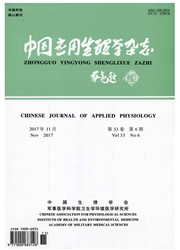

 中文摘要:
中文摘要:
目的:探讨卒中后抑郁(PSD)大鼠多导睡眠图的检测方法和变化特征。方法:雄性SD(Sprague Dawley)大鼠随机分为3组:对照组、卒中组、PSD组,通过结扎双侧颈总动脉结合孤养法、慢性不可预知应激刺激,建立PSD模型,同时将电极缝制在大鼠头皮下进行多导睡眠图监测。结果:多导睡眠图可清晰地记录大鼠活动、脑电、肌电、眼动等情况;PSD组大鼠快眼动睡眠潜伏期(REM latency,RL)为(108.2±16.1)s,较对照组(152.5±20.5)s和卒中组(145.1±18.7)s缩短,差异有统计学意义(P〈0.01);PSD组大鼠快眼动睡眠时间百分比(5.2%±1.2%),较对照组(8.3%±1.4%)和卒中组(7.9%±1.6%)降低,差异有统计学意义(P〈0.01)。结论:头皮下缝制电极法适合大鼠多导睡眠图监测应用;多导睡眠图可以做为PSD模型的一个检测指标。
 英文摘要:
英文摘要:
Objective:To explore detection method on polysomnogram of post-stroke depression and changes in rats. Methods: Male Sprague-Dawley rats were randomly assigned to control group, stroke group, and post-stroke depression (PSD) group. The establishment of PSD model generally adopted the combination of deligation bilateral common carotid artery permanently raising alone and stress exertion. And suturing electrode under the rat scalp for polysomnogram. Results: The polysomnogram could record the rats movement, electroencephalogram, electromyogram, and eye movement. The rapid eye movement(REM) latency of PSD group, and control group, stroke group were (108.2±16.1)s,(152.5±20.5)s,(145.1±18.7)s respectively. Compared with control, and stroke group, REM latency in PSD group were shortened (P0.01). The percentage of REM in PSD group, control group and stroke group were 5.2%±1.2%,8.3%±1.4%,7.9%±1.6%respectively. Compared with control, and stroke group, REM latency in PSD group was decreased (P0.01). Conclusion: The method of suturing electrode under the rat scalp is suitable for polysomnogram. The polysomnogram could be a successful sign for PSD model.
 同期刊论文项目
同期刊论文项目
 同项目期刊论文
同项目期刊论文
 期刊信息
期刊信息
